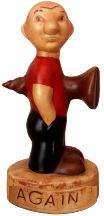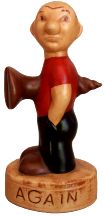 |
 The Virtual Corkscrew Museum's Weekly Newspaper |
 |
 |
 The Virtual Corkscrew Museum's Weekly Newspaper |
 |
|
Special Edition, August 13, 2007 |
Number 473 |
Corkscrews: British Design Registrations
Frank and Barbara Ellis have completed ten years of research for their new book Corkscrews: British Registered Designs. The book has 380 full colour gloss pages with 500 pictures of corkscrews. The size is 30cm x 21cm
This lavishly illustrated new reference book is a must for all corkscrew collectors, followers of product design development, and anyone interested in the history of metal working in Birmingham and Sheffield.
Some of the highlights are:
384 original registered designs for corkscrews from 1840 to 2006, with full colour pictures of examples and information about their functionality and their designers.
84 registered designs for brass figurals, a very British genre - read about their origins.
The family and business histories of 34 key designers, with over 50 historic adverts and pictures.
How British design registrations originated and how to date corkscrews from the Registration Diamond Mark or Number.
.We are pleased to present Frank & Barbara's story from the book on the Corkette:
Cork remover is part of a spy's toolkit
The Registration
We are all aware of the restrictions on carrying corkscrews on aeroplanes. But were you aware that out there on the street, that sweet innocent young lady that you pass may be carrying a lethal cork remover in her handbag?
It all started on 9 September 1963 when Spong and Company Limited of Basildon, Essex in the UK registered a design for "a cork extractor". Unusually, it was given two registration numbers (912910 and 912911), but Spong took the precaution to register both the covered and uncovered design of this cork extractor.
We now know this design as the Corkette. It was made in a variety of coloured plastics and works by pushing the hollow needle through the cork and pumping the handle up and down to inject air into the bottle. The increased pressure inside was supposed to push the cork out. However it only worked well on standard cylindrical bottles. On non-standard flask shaped bottles there was a significant risk of the bottle exploding. The Corkette was sold in a presentation case containing an instruction leaflet in up to 9 languages, all with warnings in red about the dangers of exploding bottles. The extractor itself is marked Corkette MADE IN ENGLAND U.K.PAT. NO. 986984 and the base of the case is marked SPONG & CO. LTD. BASILDON, ESSEX, MADE IN ENGLAND U.K. PAT. NO. 986984 REG. DESIGN NO 912910/1.
The British patent is from Robert Promac, Promac Engineering Ltd., London, published 24 March 1965 (filed 20 September 1962). The instruction leaflet states that it was also granted German D.B.G.M number 1882877 (Peters registrations page 69).
This is a rare case of a cork remover when both the mechanism and the design were protected - one by a patent and one by a design registration.
The Patent

The blue and green examples pictured below are probably older than the burgundy and black ones.
The Corkette was a novel device and was a reasonably effective cork extractor. But to the mind of a thriller writer it had other, more sinister uses. This fiendish device features in the novel Cover Story by Colin Forbes (1985).
His character Magda, a Swedish agent, uses one as an "innocent" murder weapon that she carries in her handbag.
"You would never guess where it comes from," Magda remarked in a soft voice. "England! They call it a Corkette. It is for taking corks out of wine bottles. You press the needle into the cork and use a pumping action. The cork slides out. One of our technicians adapted it. Who is going to suspect it is a weapon?"
"You can't ram that into someone's throat in a crowded street," the Russian objected.
"But you can ram it into your target's spinal column from behind, retract the needle and walk on. Especially in a crowded street. I carry it everywhere. Even when I go to bed," she added.
So beware, if you take a pretty Swedish lady to bed with you, don't offer her a bottle of wine. Just show her your corkscrew collection.
This is just one of 384 registered designs for corkscrews and extractors shown in the new book Corkscrews: British Registered Designs by Frank and Barbara Ellis.
For further details on the book contact Frank at frank.ellis@ntlworld.com. Tell him you read about it in The Weekly Screw.
|
©2007 Don Bull, Editor |